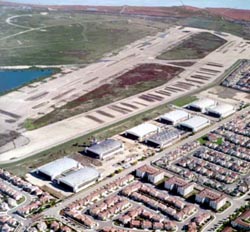
Hamilton Army Airfield, in Novato, California, was built as a bombardment base and the headquarters for the 1st Wing of the Army Air Corps, one of only three bases established for this purpose nationally. The base was utilized for the defense of the western section of the country until 1940. Hamilton Field also played a significant role during World War II in training and national defense by serving as an overseas staging area, acting as one of three major bases of the west coast wing of the Air Transport Command's Pacific Division and for its role in the Operational Training Unit Program. The base was named after Army Air Corps aviation pilot, First Lieutenant Lloyd Andrew Hamilton, originally from Marin County, California, killed while serving his country in World War I. However, the base had been previously known as the Air Corps Station, San Rafael. Construction of Hamilton Airfield commenced on July 1, 1932, with the majority of first phase construction complete by 1935.
Architecturally Hamilton Airfield is significant for its deviation in form and style from other airfields heretofore in existence. The airfield was designed in the Spanish Eclectic style and included planned landscapes which integrated natural oak groves, knolls and hills. However, perhaps most impressive of all was the development of the base as a planned community, an innovative approach in construction of Army bases which had only been adopted in the mid-1920s. Hamilton Field represented a growing trend in construction that reflected the climate, topography and history of the region in the architectural style of the base. Hence the buildings are of hollow tile or reinforced concrete construction with stucco exterior and Mission tile roofs. Architecturally the buildings consist of Spanish Eclectic with Mission, Moorish and Spanish Churrigueresque, Renaissance and Art Moderne elements. The district includes facilities such as officers' housing, a base hospital, a post theater and hangars. After the base's contributions in WWII the base was reassigned several times until buildings and land were transferred to the Navy, Army and Coast Guard. However by 1989 the Army was mandated to close its facilities on Hamilton Air Force Base.
Visit the National Park Service Travel American Aviation to learn more about Aviation related Historic Sites.
Last updated: August 29, 2017
